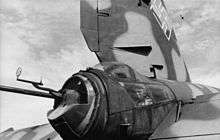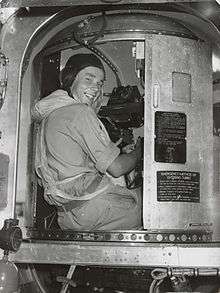Tail gunner

.jpg)
A tail gunner or rear gunner is a crewman on a military aircraft who functions as a gunner defending against enemy fighter attacks from the rear, or "tail", of the plane. The tail gunner operates a flexible machine gun emplacement on either the top or tail end of the aircraft with a generally unobstructed view toward the rear of the aircraft. While the term tail gunner is usually associated with a crewman inside a gun turret, tail gun armaments may also be operated by remote control from another part of the aircraft.
General description

The tail gun armament and arrangement varied between countries. During World War II, most United States Army Air Forces heavy bomber designs such as the B-17 Flying Fortress and B-29 Superfortress used a fixed gunner position with the guns themselves in a separate turret covering an approximately 90-degree rear arc. Typical armament was two 0.50 inch M2 Browning machine guns.

In contrast, Royal Air Force heavy bombers such as the Avro Lancaster and Handley Page Halifax used a powered turret capable of 180 degree rotation containing the tail gunner and four 0.303 inch Browning machine guns. A similar arrangement was used in the American B-24 Liberator heavy bomber (but with two 0.50 inch heavy machine guns.) British turrets were manufactured by two companies Nash & Thomson and Boulton & Paul Ltd and the same turret model could be fitted to a number of different aircraft.
In German aircraft such as the Dornier Do 17, Heinkel He 111 and Junkers Ju 88, the gun position covering the tail was often in the dorsal position at the rear of the crew compartment or part way along the back of the fuselage. This gave reasonable coverage above the line of the fuselage but might be supplemented by a ventral position, or flexible ball-mount machine gun mount at the rear of the undernose ventral Bodenlafette gondola (usually abbreviated to Bola) present on many German bomber designs of World War II, that covered the rear arc from underneath the fuselage.
In smaller ground attack aircraft and dive bombers such as the Junkers Ju 87, SBD Dauntless and later versions of the Ilyushin Il-2, the tail gunner was seated right behind the pilot and operated a machine gun on a flexible mount, either enclosed within the canopy or in an open position. In these types of aircraft, the tail gunner also usually served as the radio operator.
The tail gunner fulfilled a second role as a lookout for attacking enemy fighters, particularly in British bombers operating at night. As these aircraft operated individually instead of being part of a bombing formation, the bombers' first reaction to an attacking night fighter was to engage in radical evasive maneuvers such as a corkscrew roll; firing guns in defense was of secondary importance. The British slang term for tail gunners was "Tail-end Charlies",[1][2] while in the Luftwaffe they were called Heckschwein ("tail-end pigs").
In the autumn of 1944, the British began deploying Lancasters fitted with the Automatic Gun-Laying Turret, this was a fitted with a 9.1 cm (3 GHz) radar. The image from the radar's cathode ray tube was projected onto the turret's gunsight, allowing the gunner to fire on targets in complete darkness, with corrections for lead and bullet drop being automatically computed.
Last combat usage

The tail gunner was most commonly used during World War 2 and last used in combat during the Vietnam War (on large bombers), but the position has become largely obsolete due to advancements in long-range air combat weapons such as air-to-air missiles as well as modern detection and countermeasures against such armaments.
On 18 December 1972, during Operation Linebacker II (also known as President Richard Nixon's, "Christmas Bombing"), USAF B-52 Stratofortresses of the Strategic Air Command conducted a maximum effort bombing campaign against North Vietnam. As the bombers approached the target, SAMs (Surface To Air Missiles) commenced to explode around the Stratofortresses.[3] One bomber, callsign Brown III, completed its bomb run, and while turning outbound was warned that Vietnam People's Air Force (NVAF-North Vietnamese Air Force) MiGs were now airborne. Brown III's tailgunner, SSGT Samuel O. Turner, locked onto a fast approaching MiG-21 interceptor and shot it down with a burst of his four .50 caliber machine guns. Turner became the first bomber tailgunner to shoot down an enemy aircraft since the Korean War. His B-52 Stratofortress, tail number 55-0676, is currently preserved and on display at Fairchild AFB, Spokane, Washington.[3]
On 24 December 1972, during the same bombing campaign, the B-52 Stratofortress Diamond Lil, tail number 55-083, was attacking the railroad yards at Thái Nguyên when the aircraft's tailgunner, Airman Albert E. Moore, detected a MiG-21 at a range of 8 miles (13 km), that was climbing to intercept. Moore locked onto the MiG at 4,000 yards[4] and advised his pilot to take evasive maneuvers and the aircraft's electronic warfare officer to drop chaff and flares. He opened fire at a range of 2,000 yards, shooting around 800 rounds in three bursts. Another B-52 tailgunner, Technical sergeant Clarence W. Chute, witnessed the MiG-21 falling away on fire.[5]
By six days, Moore became the last bomber tail gunner to shoot down an enemy aircraft with machine guns during war time. Diamond Lil, was preserved and is now on display at the United States Air Force Academy in Colorado.
The last combat usage of tail gunners by the United States was in 1991, during the Gulf War. During the war, a missile struck a B-52 by locking onto the tail gunner's radar. It is disputed whether or not it was friendly fire by an F-4 Phantom[6] or an enemy missile fired from a MiG-29.[7] On October 1, 1991, Master Sergeant Tom Lindsey became the last USAF tail gunner to serve on a B-52 sortie.[8]
Partial list of aircraft with tail gun positions
This is a list of aircraft to show the different approaches to tail gun positions.
Germany

- Focke-Wulf Fw 189 – reconnaissance
- Junkers Ju 290 – long range patrol/transport
- Junkers Ju 87 – dive bomber
- Heinkel He 177 – heavy bomber
United Kingdom
- Handley Page V/1500 (introduced 1918) – heavy bomber; two Lewis guns mounted on a Scarff ring in the extreme tail
- Armstrong Whitworth Whitley (introduced 1937) – medium bomber; initially equipped with a manually operated tail turret featuring a single Lewis gun, it successively received 2- and then 4-gun Nash & Thompson turrets.
- Short Sunderland (introduced 1938) – maritime patrol and anti-submarine flying boat; 4-gun Nash & Thompson tail turret
- Handley Page Halifax (introduced 1940) – heavy bomber; 4-gun Boulton Paul tail turret
- Avro Lancaster (introduced 1942) – heavy bomber; 4-gun Nash & Thompson tail turrets: some late-war aircraft received Village Inn automatic radar aiming and others were fitted with a Rose turret.
- Vickers Windsor (first flew 1943) – prototype heavy bomber; tail gun aiming position controlling barbette-mounted Hispano 20 mm cannon in the rear of the engine nacelles.
- Vickers Wellington- medium bomber fitted with two Browning M1919s in the tail turret
USA

- TBD Devastator – carrier-borne torpedo bomber; rear of cockpit flexible gun mount
- TBF Avenger – carrier-borne torpedo bomber; featured both a dorsal turret and a ventral tail gunner
- B-17 Flying Fortress – heavy bomber; fixed tailgun position from the B-17E version onwards
- B-24 Liberator – heavy bomber; rotating tail gun turret
- B-25 Mitchell – medium bomber
- B-26 Marauder – medium bomber
- B-29 Superfortress – heavy bomber
- B-36 Peacemaker – Strategic Air Command heavy bomber
- B-47 Stratojet – Strategic Air Command heavy bomber
- B-50 Superfortress – heavy bomber
- B-52 Stratofortress – Strategic Air Command Vietnam War heavy bomber
- B-58 Hustler – Strategic Air Command supersonic bomber
USSR/Russia
- Antonov An-12
- Ilyushin Il-28
- Ilyushin Il-2
- Ilyushin Il-4
- Ilyushin Il-10
- Ilyushin Il-40
- Ilyushin Il-102
- Ilyushin Il-76
- Myasishchev M-4
- Petlyakov Pe-2
- Petlyakov Pe-8
- Tupolev SB
- Tupolev TB-3
- Tupolev Tu-2
- Tupolev Tu-4
- Tupolev Tu-14
- Tupolev Tu-16
- Tupolev Tu-22/Tu-22M
- Tupolev Tu-95/Tu-142
See also
- Ball turret
- Joseph McCarthy ("Tail-gunner Joe")
- Wallace McIntosh
References
- ↑ Johnson, Richard Riley (1995). Twenty Five Milk Runs (And a few others): To Hell's Angels and back. Victoria, Canada: Trafford Publishing. p. 96. ISBN 1-4120-2501-X. Retrieved 2009-10-30.
- ↑ In the USAAF the term was adopted as the last bomber in a unit formation, or the last unit formation in a larger bomber stream, both considered highly vulnerable.
- 1 2 McCarthy, p. 139
- ↑ McCarthy, p. 141
- ↑ Branum, Don (27 December 2010). "B-52 Tail-gunner Recalls MiG Downing (Vietnam)". Office of the Secretary of Defense Public Affairs. Retrieved 1 September 2014.
- ↑ Tucker, Spencer. "U.S. Conflicts in the 21st Century: Afghanistan War, Iraq War, and the War".
- ↑ Safaric, Jan. "Iraqi Air-Air Victories" (PDF).
- ↑ Condor, Albert. "Air Force Gunners".
- McCarthy, Donald J. Jr. MiG Killers; A Chronology of US Air Victories in Vietnam 1965–1973. 2009. ISBN 978-1-58007-136-9.